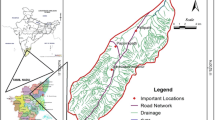Abstract
Forestry and agricultural land uses constitute 85% of Korea and these land uses are typically mixed in many watersheds. Land cover is one of the most important factors affecting diffuse pollution and water quality. The aim of this study is to estimate the pollutant concentrations in runoff from four study watersheds consisting of a mix of forestry and agricultural land uses at different ratios in the Geum River Basin. The effect of topographical variables was also considered. The ratio of agricultural land use to the total area of study watersheds was in the range of 0.01’.36. Flow rate and water quality (suspended solids, organics and nutrients) of runoff from 40 rainfall events were monitored at the study watersheds. Descriptive statistics showed higher nutrients and organic concentrations in runoff from watershed with higher agricultural activities. Event Mean Concentration (EMC) of individual runoff event was calculated for each water quality constituent based on the flow rate and concentration data of runoff discharge, and arranged on a cumulative probability scale according to runoff occurrence. From the correlation analysis between EMC data and affecting variables, the ratio of agricultural land use to the total area was identified as the parameter that most affected the magnitude of EMC.
Similar content being viewed by others
References
APHA, AWWA, WEF, WPCF (1998). Standard methods for the examination of water and wastewater18th ed.
Arnold, J. G., & Allen, P. M. (1996). Estimating hydrologic budgets for three Illinois watersheds. Journal of Hydrology, 176, 57’7.
Brezonik, P. L., & Stadelmann, T. H. (2002). Analysis and predictive models of stormwater runoff volumes, loads, and pollutant concentrations from watersheds in the Twin Cities metropolitan area, Minnesota, USA. Water Research, 36(7), 1743’757.
Fisher, D. S., Steiner, J. L., Endale, D. M., Stuedemann, J. A., Schomberg, H. H., Franzluebbers, A. J., et al. (2000). The relationship of land use practices to surface water quality in the Upper Oconee Watershed of Georgia. Forest Ecology and Management, 128, 39’8.
Gardi, C. (2001). Land use, agronomic management and water quality in a small Northern Italian watershed. Agriculture, Ecosystem and Environment, 87, 1’2.
Jain, C. K. (2002). A hydro-chemical study of a mountainous watershed: The Ganga, India. Water Research, 36, 1262’274.
Kim, S. W., Kim, T. H., Kim, G. H., Choi, S. I., & Choi, E. (2004). Diffuse sources contribute non-biodegradable COD in reservoirs in Korea. In 8th diffuse/nonpoint source pollution IWA special conference, Kyoto, Japan, CD-Rom.
Marani, M., Belluco, E., D’Alpaos, A., Defina, A., Lanzoni, S., & Rinaldo, A. (2003). On the drainage density of tidal networks. Water Resources Research, 39(2), 1040’050.
Maul, J. D., & Cooper, C. M. (2000). Water quality of seasonally flooded agricultural fields in Mississipi. USA. Agriculture, Ecosystems and Environment, 81, 171’78.
Mosello, R., & Machetto, A. (1996). Chemistry of atmospheric wet dispersion in Italy: Results from a five-year study. Ambio, 25, 21’5.
Novotny, V. (1999). Integrating diffuse/nonpoint pollution control and water body restoration into watershed management. Journal of the American Water Resources Association, 35(4), 717’27.
Novotny, V., & Olem, H. (1994). Water quality: Prevention, identification, and management of diffuse pollution (p. 1054). New York: Van Nostrand Reinhold.
Park, H., Hyun, I. H., & Park, C. H. (1998). Needs and options of Korea for integrated water management. Journal of Water Services: Research and Technology. AQUA, 47(2), 57’7.
Thierfelder, T. (1999). The role of catchment hydrology in the characterization of water quality in glacial/boreal lakes. Journal of Hydrology, 216, 1’6.
Tong, S. T. Y., & Chen, W. (2002). Modeling the relationship between land use and surface water quality. Journal of Environment and Management, 66, 377’93.
UNEP (2004). GEO yearbook 2003 (p. 80). New York, NY, 10017, USA: United Nations Environment Programme.
USEPA (1983). Results of the Nationwide Urban Runoff Program, vol. 1. Final Report. Water Planning Division, U.S. EPA, Washington DC.
USGS (1998). The National Flood-Frequency Program-Methods for estimating flood magnitude and frequency in rural areas in Arkansas. USGS Fact Sheet 128’7.
Withers, P. J. A., & Lord, E. I. (2002). Agricultural nutrient input to rivers and ground waters in the UK: Policy, environmental management and research needs. Science of the Total Environment, 282’83, 9’4.
Author information
Authors and Affiliations
Corresponding author
Rights and permissions
About this article
Cite this article
Kim, G., Chung, S. & Lee, C. Water quality of runoff from agricultural-forestry watersheds in the Geum River Basin, Korea. Environ Monit Assess 134, 441–452 (2007). https://doi.org/10.1007/s10661-007-9635-0
Received:
Accepted:
Published:
Issue Date:
DOI: https://doi.org/10.1007/s10661-007-9635-0




